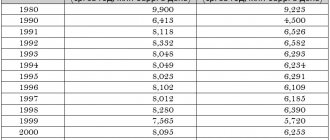Why is oil measured in barrels in the USA, and in tons in the Russian Federation?
The reason for measuring oil volumes in “barrels” (barrels) in the USA : oil is very different from each other (see types of oil above), so since the 19th century it was customary to supply oil in the USA in barrels (barrels), for each of which the oil refinery could pay different prices.
The reason for measuring oil volumes in tons in the Russian Federation is the legacy of the USSR , when, under the conditions of a planned economy and approximately the same quality of oil from one field, the volumes of oil produced were calculated in tons.
Price
When oil price quotes are published, they often include the Brent brand. Its market share is small, but in terms of quality it is considered the standard - it is the lightest and contains the least sulfur. The cost of other brands, including Russian Urals and Siberian Light, is closely related to it.
Another commonly used standard is WTI (West Texas Intermediate). It is close in quality to Brent and is mined in Texas, USA.
The price is influenced by a variety of factors:
- policy;
- economic relations;
- ecology;
- production volumes;
- variety;
- government reports on domestic market performance;
- sanctions against states;
- others.
The price of a barrel of oil has become a kind of indicator of political and economic stability in some regions of the planet. Moreover, sometimes even experts cannot predict an increase or decrease.
This is interesting: Crude oil exports: Russia is turning to the East.
Throughout the history of commodity trading, the price has fluctuated in a very wide range, falling below 20 and rising above 100 dollars.
It reached a peak of $147 per barrel on June 11, 2008, then fell sharply. Just at this time, the global economic crisis was gaining momentum.
In September 2022, prices fluctuated in the range of $50-60 per barrel.
How many liters and tons of oil are in a barrel?
1 barrel of oil = 0.125 - 0.1373 tons, depending on the density of different types of oil . So,
- Brent oil (UK, Norway): density in 1 ton = 7.59 barrels, 1 barrel = 0.1318 tons;
- Turkmen Blend oil (Turkmenistan): 1 ton = 7.37 barrels; 1 barrel = 0.1356 t;
- Azeri Light oil (Azerbaijan): 1 ton = 7.37 barrels; 1 barrel = 0.1356 t (i.e. almost identical to Turkmen);
- Urals oil (Russian Federation): 1 ton = 7.28 barrels; 1 barrel = 0.1373 tons;
- Siberian Light oil (Russian Federation): 1 t = 7.45 barrels; 1 barrel = 0.1342 tons;
- Tengiz oil (Kazakhstan): 1 ton = 7.95 barrels; 1 barrel = 0.1257 tons;
Blue barrel
Surely many have wondered why the double letter “b” (bbl) is used in the English abbreviation for 1 barrel of oil. Many agree that the second letter "b" came into use after the well-known Standard Oil began to paint its barrels blue, thereby ensuring that the container exactly contained 42 gallons.
However, this version failed after the discovery of a document in which the designation bbl appears 100 years before the discovery of oil-bearing areas. In the 18th century, this designation was indicated on cargo that had nothing to do with hydrocarbons - honey, rum, whale oil, etc.
Thus, it still remains a mystery where such a name for a volume measure came from. However, no one is in a hurry to solve it, since this will not affect the quotes in any way.
Exchanges of the world that determine the price of 1 barrel of oil
- Chicago Mercantile Exchange (CME)
- Euronext exchange and its subsidiary - London International Financial Futures and Options Exchange - LIFFE
- Singapore Exchange (SGX);
- Australian Securities Exchange (ASX)
- Intercontinental Exchange (ICE);
- London Metal Exchange (LME) is the owner and operator of the Hong Kong Stock Exchange HKE;
- Moscow Exchange (MOEX);
Origin of the term
English barrel
Even in ancient times, a barrel (bbl) was a measure of the volume of liquid and granular bodies and was actively used both in everyday life and in trade. Its name comes from medieval England and translated simply means... barrel. Spirits such as ale, wine and beer had to be stored somewhere and somehow transported. And wheat, rye and other grain crops also required convenient containers, so the barrel was a suitable container for all these products.
However, the answer to the question “How much is one barrel in liters?” not so clear. The fact is that its volume always depended on what product was stored in it. For example, in 1454 the beer barr. in England it contained 32 ale gallons of ale, which was equal to 147.88 liters of ale, or 36 ale gallons of beer, which in terms of our volume measure was equal to 166.36 liters. These ratios have varied over the years, suggesting that there is no single standard of measures in this area. To measure the volume of bulk solids, the so-called English barrel was used, equal to 163.66 liters.
Barrel in Rus'
The value varied not only depending on what it was measuring, but also depending on which country the unit of measurement was used in. Take Russia, for example. There the barrel was called a barrel. After all, storing and transporting anything in barrels was very convenient and almost the only means. Therefore, coopers in Rus', that is, the artisans who made these containers, were quite wealthy people.
But the volume of a Russian barrel was different from the volume of an English barrel. The Russian measured barrel, or, as it was also called, the forty barrel, contained 40 buckets (hence the name). In terms of liters, its volume was then about 492 liters. This container was used to store linseed and hemp oils, as well as alcohol.
In addition to the measuring barrel, volume units such as beer barrels and Riga barrels were widely used. They contained 10 and 12.5 buckets, respectively, which in modern units was about 123 and 154 liters. However, resin or gunpowder, also stored in barrels, was no longer measured in buckets and barrels, but in pounds . So, a barrel of gunpowder weighed 10 pounds, and a barrel of resin weighed about 9 pounds.
American barrel
In the process of colonization of the North American continent and the rapid development of trade in the conquered territories, the American barrel began to be actively used. But it held less liquid than the English, and was 31 US gallons for beer, which was equal to 117.3 liters (the so-called “standard beer barrel.”). To measure the volumes of all other liquids a standard wine barrel , equal to 31.5 US gallons (119.24 liters). For bulk solids, a dry barrel , equal to 105 dry quarts or 115.6 liters.
Other barrels
The widespread use of the barrel in Europe and Russia speaks of its versatility. Take France, for example. There this unit of measurement is called “ barrique ” (from the French barrique). If we take the most common Bordeaux measure (or Bordeaux barrel ), then the volume of the barrique will be 60 old wine gallons or 225 liters. In the recent historical past, Burgundy barrique , equal to 228 liters. And in Poland they used the so-called Polish barrel, which held 8 buckets, or 98.4 liters. Thus, the notorious barrel, barrique, also known as a cask, turned out to be a very convenient measure of volume.
Other barrel measurements than the US barrel of oil
A barrel of oil should be distinguished from an ordinary barrel , which is used in the world to measure the volume of other liquids or bulk materials. In particular:
- 1 standard US barrel of liquids = 31.5 US gallons = 119.2 liters
- 1 English beer barrel is 36 English gallons = 163.66 liters;
- 1 “English” barrel of bulk solids is 4.5 bushels = 163.66 liters;
- 1 French barrel = 225 liters;
- 1 Burgundy barrel (wine) = 228 liters.
Did you like our new published material on the Masterforex-V wiki? If yes, leave your feedback under this article and share it on social networks.
Sincerely, wiki Masterforex-V, free (school) and professional training courses Masterforex-V for working on Forex, stock, futures, commodity and cryptocurrency exchanges.
What is a barrel and where did it come from?
You might be interested in:Pearson distribution: definition, application
A barrel of oil is a standard unit of volume in the oil trade and is equal to 42 gallons or 159 liters.
When oil production was not at industrial scale, its popularity was not so high and little trade took place, so there was no need to establish a single measure of volume.
After American industrialists got down to business, oil was able to displace whale oil, which was used to illuminate houses and streets. Kerosene, obtained from oil refining, gained worldwide popularity, and the demand for oil began to grow exponentially. In this regard, oil workers had to look for a single container in which it would be convenient to transport and sell raw materials.
Initially, wooden whiskey barrels were used to transport oil, but their volume was not always the same: if the volume was larger, traders suffered losses. This was the main reason for establishing a single volume measure for oil trading.
In August 1866, at the next meeting of independent oil industrialists, a single volume of commercial oil was established - 42 gallons. This value was not chosen by chance. Fish and other products were sold in barrels with a volume of 42 gallons - this was the maximum permissible weight that a person could lift, and the minimum volume that was profitable to transport.
Another 6 years later, the American Petroleum Association officially recognized the oil barrel as the standard for trading fossil fuels.
How much gasoline can be obtained from 1 ton of oil?
As mentioned above, one ton of Russian oil contains approximately 7.3 barrels of crude oil. After some simple calculations (multiplying 102 liters of gasoline obtained from one barrel of Russian Urals oil by 7.3), we get 744.6 liters.
Interesting materials:
How to read the code using your phone? How to read a barcode with your phone? How to take a photo of the screen on your phone? How to take a photo of an Android phone screen? How to sync two Xiaomi phones? How to sync contacts from Google to Samsung phone? How to sync contacts to a new phone? How to sync contacts from your phone to your Google account? How to sync phone contacts with WhatsApp? How to sync headphones with your phone?
What is bbl and where does this name come from?
The American barrel is abbreviated as “bbl”. Where this reduction came from is still not known exactly. Most are inclined to believe that this is a translation from “blue barrel”.
The color “blue” came from the color of oil barrels, which were previously supplied by the largest company Standard Oil.
The second version is that another letter b appeared to distinguish barrels from bales. In English, "bale" is "bale".
Another version is that BBL is branding BL (fuel barrel).
Oil barrel
Since the beginning of oil production in the 19th century, barrels. began to be used for its storage and transportation, which further served to consolidate this “non-systemic” unit of measurement throughout the world. This is how the oil barrel was born. This turned out to be very convenient, since there was no need to use different types of containers, and all payments for oil could be made based on the price per barrel.
One day in 1866, several independent oil industrialists met in the American state of Pennsylvania to discuss important issues in their business. One of these discussed issues was the choice of standard containers for storing and transporting oil. It was decided to use a standard barrel. with a capacity of 42 US gallons. Today, a barrel of oil in liters is 158.987 liters.
On a note:
- 1 US oil barrel = 42 US gallons = 158.987 liters;
- 1000 liters (l)=1 cubic meter meter (m³)=6.290 US oil barrel.
But why this particular number? The fact is that by the beginning of the 18th century, wooden barrels with a volume of 42 gallons had proven themselves well as almost the only sealed container. They actively transported wine, molasses, fat, fish and many other food products. Such barrels were convenient to carry and transport on the ships available at that time, and stored in warehouses. That's why the heads of the oil cartels decided in 1872 to approve the barrel. 42 gallons as the standard unit of oil volume.
Since then, the volume of oil in international trade has been measured in barrels. Although with the same success it would be possible to measure not the volume of oil produced, but its mass, as is done for metal, coal and grain. What's the difference? Only in units of measurement. The adoption of the barrel was historically determined by the prevailing conditions at that time. In addition, oil is a liquid, and it is volume rather than mass that is preferable for it. A barrel of oil is much easier to imagine than a ton of oil. Nevertheless, on the domestic Russian oil market, calculations are carried out precisely in tons, and not in barrels.
In this regard, a pertinent question arises: how many barrels are in a ton of oil and how many kilograms does one barrel weigh? oil? This question could have been answered unequivocally, if not for the fact that oil, unlike, for example, ordinary water, has different densities . This means that each brand of oil has its own density. For the main brands of Russian oil, this value ranges from 820 to 905.5 kg/m³. Therefore, the number of barrels for one ton of such oil will range from 7.671 to 6.946 barrels, and one barrel. will weigh from 130.369 to 143.963 kg or from 0.130 to 0.144 tons, respectively.
Here are simple formulas for converting tons to barrels and vice versa:
- volume (in barrels) = K × weight (in tons),
- weight (tons)=volume (barrels)/K,
where the K coefficient ranges from 7.329 to 7.240 bbl/t (on average K=7.284 bbl/t) for Ural oil and from 7.463 to 7.418 bbl/t (on average K =7.441 barrels/t) for Siberian Light oil.
This coefficient depends not only on the density, but also on the temperature of the oil.
What determines the price of oil
As you know, the price of black gold is quite volatile and depends on several key factors:
- Production volume;
- Policy (sanctions);
- Risks associated with military conflicts in exporting countries;
As you know, the price of any product is determined by supply and demand. If demand increases, then the price goes up and vice versa. The volume of oil demand is usually quite stable. Therefore, if one of the countries begins to “pump” more black gold, then automatically there is too much supply on the market and prices fall.
To regulate production, the organization of oil exporting countries OPEC (from the English “Organization of Petroleum Exporting Countries”, OPEC) was created, which allows the level of production to be coordinated between countries in order to stabilize prices.
Related posts:
- OPEC - what is this organization, composition and goals of creation
- What things are made from oil - a list of more than 53 products
- Global economic crisis - what it is, causes and history
- Beta (β) in stock analysis - what...
- Gross and net - what is it, formula
- Conglomerate - what is it and what is it for?
- Green economy - detailed description
- Embargo - types, purposes and reasons for entering











